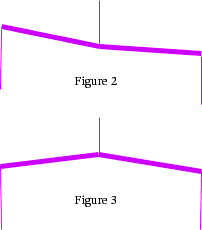![]()
![]()
Humans have used mass and volume as alternative properties for measuring objects for a very long time. One of the earliest tools for measuring mass, a balance, was found in a 7000 year old Egyptian tomb. Mass and volume have different advantages and disadvantages. We will investigate those in Chapter 2. Because mass plays a fundamental roll in the development of understanding our world, it will be valuable to develop a deeper understanding of mass.
Everyone has experienced mass all our lives. But many people remain confused about what is mass, and what is not. There are two distinct characteristics of mass that provide methods of measure. (1) Mass resists accelerations. So mass can be measured by trying to make a moving mass stop, change speed or direction of motion. (2) Gravity exerts force on mass. Gravitational force can act as a measure of mass. But gravitational force acts between two or more masses. So we must be careful not to confuse the force, called weight, with the individual mass we wish to find. Weight can vary at different locations. This difference can be canceled out by comparing two masses. The balance is such a device.
There are a variety of balances that would be useful for later experiments. But most have many aspects in common. To understand how to best use balances and avoid common difficulties, it will be useful to construct, calibrate, and determine the limitations of a simple balance.
Construct an equal arm balance. This will be a challenging opportunity to be creative. The concept seems childishly simple. (See Figure 1.) But you may find the task frustrating because making a good balance is much more difficult than first appearances. For reasons we will later want to understand, a perfect balance is actually IMPOSSIBLE!
Find needed materials. A beam to act as the lever for the balance can be constructed by folding a wide strip of heavy paper lengthwise. Alternatively a common school ruler designed to store in a three ring notebook might be a suitable balance beam. It has a hole in the middle and one at either end. Tie separate lengths of string through each hole. Other materials could substitute. As a first test, hang two apparently equal objects from the end strings and hold the balance by the middle string to see if the objects balance. If one object always swings down, even if you switch ends, then that end's object is probably more massive.
If the middle hole (called the fulcrum in lever terminology) is below a straight line connecting the end holes (as in Figure 2), the balance will be unstable. If the middle hole is above a straight line connecting the end holes (as in Figure 3), the balance will be stable but less than perfect. To compare two masses, the balance must be stable. (If your ruler is straight, it may be stable due to the fulcrum being above the line between end supports by the diameter of the holes.) To be precise, the balance must have very little friction. To be sensitive to small differences in mass, the balance must also be stable but nearly unstable. (Experiment 1-7 will measure sensitivity.) To be accurate the balance must also be well calibrated with known masses. (Experiment 1-6 will calibrate the balance.)
To use your balance to determine if the objects have equal (the same) masses, the distances from the fulcrum to the two end supports must be equal. In addition, the balance without any objects should not have one end heavy. To zero the balance, many commercial balances have adjustment screws. But a simple balance might be adjusted by removing some of the heavy end using sandpaper or rubbing on a cement walkway. Friction might be reduced by using thread rather than string.
To make your balance more useful, you might want to build a support (perhaps hanging the balance from a door jamb using a bent paper clip as a hook). Paper baskets or pans could be attached to the balance ends to make it easier to hold the objects to be compared.Try adding sticky bits of material (chewing gum?) at different locations on you balance to investigate changing stability. Try checking a number of objects that are likely to have equal masses to determine if you can detect differences.
Record your results in your science journal and write a formal report to earn credit.
If a ready-made balance is available, attempt to see how the manufacture addressed the issues of stability, friction, precision, sensitivity, and zeroing. Add mass to different locations on the balance (perhaps using a clothes pin) to investigate changes in stability.
It might be worth it to ponder the properties of our universe which make using and measuring with a balance possible. Or it may be easier to consider what a universe based on different principles might be like. Consider a universe where no CHANGE ever occurs (either beneficial or harmful), and everything is perpetually static; measurement would probably be both impossible and meaningless. In a universe where the results from identical situations varied (maybe the same object would be progressively heavier on successive measurements), things might be a whole lot more difficult. And if identical efforts just produced random results, there likely would be no use even trying to understand that universe; trying to learn to improve one's existence might be impossible.
But fortunately we live in a universe where change is possible, but identical changes produce similar results so we can learn the patterns and use them to improve our lives.
![]()
to Experiment 1-6
to Physical Science menu
to site menu